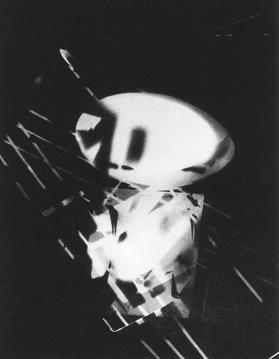 László Moholy-Nagy Photogram (Oval study) 1926
László Moholy-Nagy Photogram (Oval study) 1926
László Moholy-Nagy
In modernism, there are only a select few who are associated with the development of ideas and practises in the medium of photography. However, one of these fathers of modern art is Hungarian born, László Moholy-Nagy.
Maholy-Nagy and his wife, Lucia Maholy, continually experimented with the photographic process and they soon developed a way of exposing light sensitive paper with objects overlaid on top of it, called a photogram. I was fortunate to witness first hand a It is one of these photograms that we will now discuss. “Oval study”/Photogram 1926 (above) was created while Maholy-Nagy was still at the Bauhaus in Germany. The technique involves no negative and therefore has no need for a camera. The photographic paper is directly exposed either using the enlarger or a lamp as the light source. This technique puts the emphasis onto the artist and removes the human-machine relationship the photographer usually contends with. This photogram has been created using a number of different objects which have been added and removed at different stages of the exposure. Maholy-Nagy had complete control over the arrangement of objects and the manipulation of light. It is too hard to hazard a guess at the identity of the specific objects. However, there appears to be an egg shaped object, alongside some long thin lines, which almost mimic guitar strings. This photograms heightens our intrigue by posing endless questions behind his intentions, leaving it open for each individual’s own interpretation.
The egg shape appears to be the most striking of the objects, not just because of it’s shape but how Maholy-Nagy leaves it stationary/exposed for the longest amount of time creating a dominant glow. As for the rest of the photo, the overall impression is one of drama, which is heightened by the strong contrast. He purposefully moves each item as he exposes it to the light which in turn creates an eerie feel through the faint shadows/silhouettes it leaves behind. This gives a more three-dimensional feel to the objects, drawing them out of the photogram.
As well as the egg, are eyes are also drawn by his clever mix of hard line formation and soft tones. The lines lead our eyes very naturally from the bottom right to the top left. (Left) I have inverted the tones to put emphasis on the main shapes, forms and compositional elements. The composition does not fit into normal photographic compositional rules, such as the rule of thirds, which Ansel Adams pioneered at a similar time. However, I find the image has a great deal of pictorial rhythm
His careful use and arrangement of the objects please a pure aesthetic desire for both the artist and us the viewer. This photogram is a prime example of modernist ideals in practise. To explain this, there is first a need to explore what modernism is.
In Western art, Modernism self-consciously rejected the past as a model for the art of the present. This is where the route of the name modernist or modern art comes from. Modernism proposes new forms of art on the grounds that these are better suited to the present time. Therefore, it is characterised by constant innovation and progression. Maholy-Nagy was noted for having these characteristics and his teachings strongly backed up these ideas. Modernists believed that one could communicate the universal meanings of life through the formal qualities in a piece of work. Throughout modernism the belief in these formal qualities and the notion of a pure aesthetic experience were major themes. Modernism originally gained pace from about 1850. It usually refers to the succession of art movements that critics and historians have identified from the realism of Gustave Courbet, to its climax in abstract art and its developments up to the 1960’s. By this time Modernism had become a dominant area of art and soon provoked a reaction which was quickly dubbed Postmodernism. Having said this, many critics still recognise that forms of late modernism still remain right into the 21st century, although the main ideas have been increasingly challenged.
As I have previously stated, there are only a few photographers who were associated with the avant guard of modernism. The cubist and dadist inspired photogram experiments of Christian Schad had in turn inspired the American born, Man Ray. Man Ray pushed the creative and technical possibilities of this process which he dubbed “rayographs”. Through his famous photograms, Man Ray became recognised as a major international influence and was associated with artists such as Marcel Duchamp and Francis Picabia. Like Maholy-Nagy, Man Ray started out using paint and even sculpture instead of the photographic process. However, he soon went onto push the boundaries of light manipulation and is now recognised as one of the great masters of the photographic medium. There are a few other artists/photographers which are worth mentioning, however, Man Ray has interesting similarities in his work, to that of Maholy-Nagy. It is interesting that Maholy-Nagy claimed that he discovered the photogram without knowing the works of either Man Ray or Christian Schad.
As a technique I enjoy the process, as an artist I find him inspiring. However, as an athesetic I find most modernist or specifically mimilaist styled imagery such as this lacking something. I think this is due to a lot of my ideals have been shaped by post-modernism. I do not concider myself or my own work post-modernist, but I do beleive that art needs to engage with the world and its issues.
Either way you cannot reject the importance he has had on the modern history of photography.
Further references:
Laszlo Moholy-Nagy: The Art of Light by Oliva Maria Rubio, Vicenzo Vitiello, Hattula Moholy-Nagy and Laszlo Moholy-Nagy (Sep 30, 2010)
Laszlo Moholy-Nagy: The Photograms by Herbert Molderings, Renate Heyne, Hattula Moholy-Nagy and Laszlo Moholy-Nagy (Jan 31, 2010)
http://www.moholy-nagy.com/ Accessed November 2010, used for historical records and biographical information.
